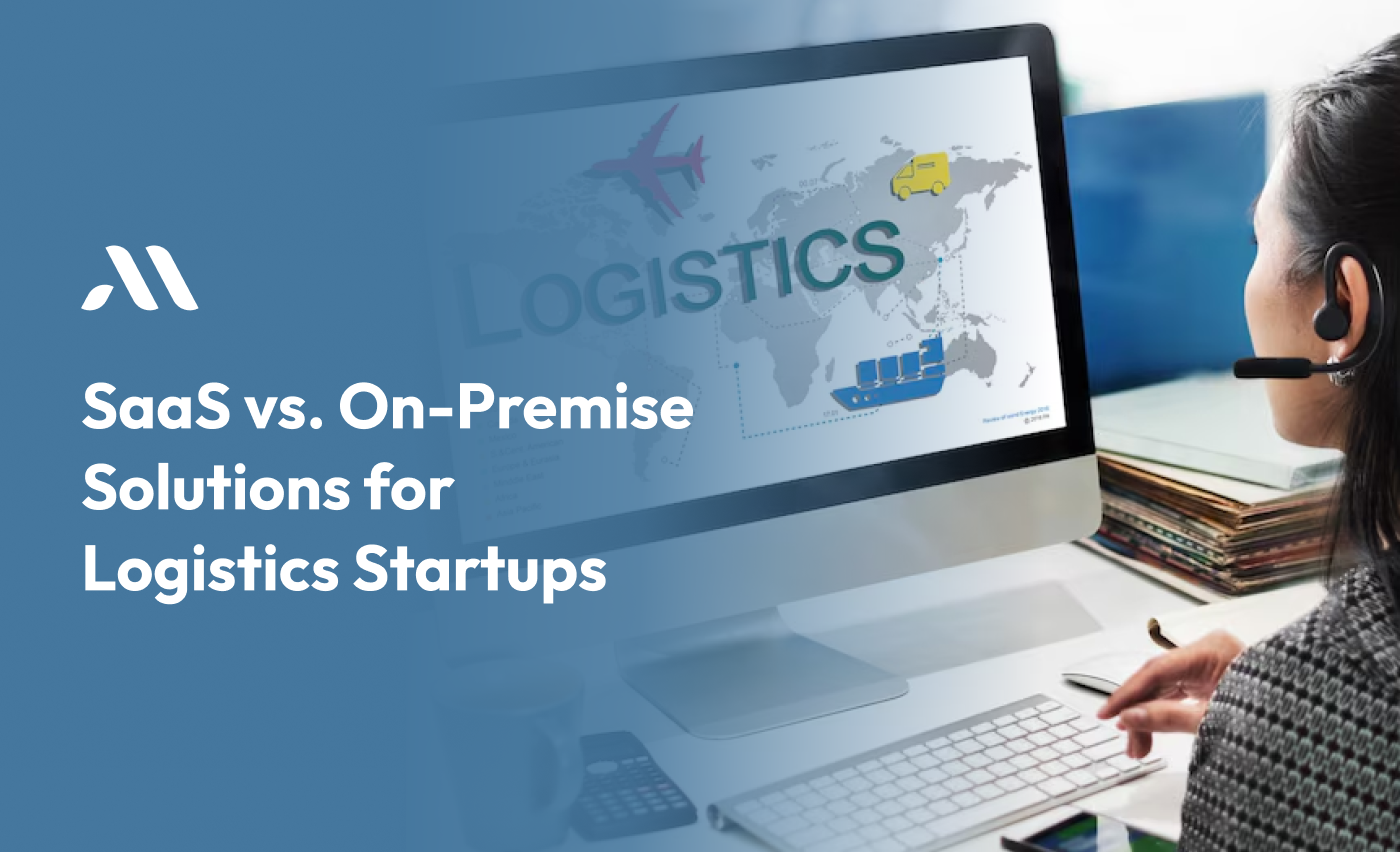Starting a logistics business is an exciting venture, but it comes with a lot of challenges. One big decision logistics startups face is choosing between SaaS vs On-Premise Solutions for managing their operations. These two technologies help businesses run smoothly, but they work in different ways.
In this blog, we'll break down what SaaS (Software as a Service) and On-Premise solutions are and their pros and cons, and we'll help you decide which one is the right fit for your logistics startup.
What is SaaS?
SaaS (Software as a Service) is a cloud-based service where software is hosted on a remote server and accessed via the Internet. You don't need to install the software on your computer. Instead, you use it online, and the service provider handles all updates.
For example, think of popular tools like Google Drive or Shopify. These are SaaS tools because you log in from your browser, and they manage the infrastructure for you.
For logistics startups, SaaS solutions can be a great way to manage your entire operation, from shipping to warehousing, and even customer communication.
What is an On-Premise Solution?
On the other hand, an on-premise solution is software that is installed and run on computers or servers in your office or warehouse. You have full control over the system, which also means that you are responsible for the upkeep, maintenance, and upgrades.
An example of an On-Premise solution could be custom logistics management software that you install on your company’s servers.
SaaS vs On-Premise Solutions: Which is Better for Your Logistics Startup?
When deciding between SaaS vs On-Premise solutions, there are several important factors to consider.
1. Cost
One of the biggest differences between SaaS vs On-premise solutions is the cost. With SaaS, you typically pay a monthly or annual subscription fee. This includes maintenance, support, and updates, so you don’t have to worry about surprise costs.
On-premise solutions, on the other hand, come with higher upfront costs. You need to buy a software license, invest in hardware, and hire IT staff to manage the system. You also need to handle upgrades and maintenance yourself.
Note: According to a 2023 report, SaaS adoption in businesses has increased by over 20% in the past five years, mainly due to cost-effectiveness.
2. Deployment and Setup
SaaS solutions are generally quicker to deploy. Since everything is hosted in the cloud, you can start using the system almost immediately after signing up.
With On-Premise solutions, setup takes more time and effort. You need to install the software on your servers and may require a dedicated IT team to manage the deployment.
Tip: If your logistics startup needs to get up and running quickly, SaaS might be the better choice.
3. Scalability
For logistics startups looking to grow, scalability is important. SaaS solutions are built to scale with your business. As your startup grows, you can easily upgrade your plan or add more users with a few clicks.
In contrast, On-Premise solutions may struggle to scale without significant investment in new hardware and IT resources. This can slow down your growth and add more complexity to your operations.
Remember: SaaS solutions allow you to expand with minimal hassle, while On-Premise solutions require more resources to grow.
4. Maintenance and Support
One of the key benefits of SaaS development is that maintenance and support are included in the subscription. This means that your provider handles software updates, bug fixes, and security patches for you.
In an On-Premise system, you are responsible for maintaining the software and keeping it up to date. You’ll need to hire IT experts to handle any issues or system updates.
"A startup’s time is best spent on innovation, not maintaining infrastructure."
5. Customization and Control
If your logistics startup requires a highly customized system, On-Premise solutions might be the better choice. You have full control over the software and can modify it to meet your specific needs.
However, SaaS solutions offer limited customization since they are designed to cater to a wide range of businesses. Some SaaS providers offer customization options, but these are usually not as deep as what you’d get with an On-Premise solution.
6. Security
Security is a major concern for logistics startups, especially when handling sensitive customer data. SaaS solutions are hosted by third-party providers who manage security protocols. These companies invest heavily in ensuring their platforms are secure, but you rely on them for the safety of your data.
With On-Premise solutions, you have full control over your data and can implement your security measures. However, you are responsible for protecting your system against cyberattacks, which can be costly and complicated.
According to a recent study, over 80% of businesses trust cloud providers to offer better security than their systems.
When to Choose SaaS for Your Logistics Startup
Limited Budget: If you’re a startup with a limited budget, SaaS solutions offer a lower upfront cost and no need for additional hardware.
Quick Setup: SaaS helps you to get started quickly without the need for complex installations or IT teams.
Easy Scaling: If you expect rapid growth, SaaS will allow you to scale with ease, adding new features or users without much hassle.
Maintenance-Free: SaaS providers handle updates and security, so you don’t need to worry about maintaining the system.
Also Read - How Custom App Development Helps Logistics Businesses Scale
When to Choose On-Premise for Your Logistics Startup
Need for Control: If you need total control over your software and data, an On-Premise solution might be the better option.
Customization: On-Premise solutions are more customizable, making them ideal if your logistics business has very specific requirements.
Long-Term Cost Savings: While On-Premise solutions have higher upfront costs, they may offer long-term savings if you have the resources to maintain and scale the system internally.
Final Thoughts: SaaS vs On-Premise Solutions for Logistics Startups
Both SaaS vs On-Premise solutions have their pros and cons. For logistics startups, SaaS development often provides a cost-effective, scalable, and low-maintenance option. However, if your business requires deep customization and you have the resources to maintain an internal IT team, an On-Premise solution might be the right choice.
Looking for the best solution to manage your logistics business? MicraSol can help! Our expert team builds powerful, easy-to-use apps tailored for logistics startups. Whether you need a custom solution or a scalable SaaS app, we've got you covered. Contact MicraSol today to boost your operations!
FAQS
What is the difference between SaaS and On-Premise solutions?
- SaaS (Software as a Service) is a cloud-based system where you access the software online. You don’t need to install anything, and the service provider takes care of updates and security.
- On-premise solutions are installed on your servers or computers, and you manage everything, including updates and security, by yourself.
Which one is cheaper: SaaS or On-Premise?
- SaaS usually has lower upfront costs because you pay a monthly or yearly fee, and maintenance is included.
- On-Premise has higher upfront costs because you need to buy the software, servers, and hire IT staff. However, it might be cheaper in the long run if you already have the resources to manage it.
Which is easier to set up: SaaS or On-Premise?
- SaaS is quicker and easier to set up. You just sign up online, and you’re ready to go.
- On-premise takes more time because you have to install it on your servers and set everything up yourself.
Which one is better for a small logistics startup?
- SaaS is usually the better choice for small logistics startups because it’s cost-effective, easy to scale, and doesn’t require a big IT team.
- On-Premise might be better if you need full control over the system and have the budget to manage it.
Can I customize SaaS and On-Premise solutions?
- SaaS offers limited customization because it’s designed to work for many different businesses.
- On-Premise is more customizable, so you can tailor it to your specific needs, but you’ll need a team to handle the modifications.








